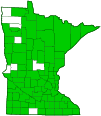red admiral
(Vanessa atalanta)
Conservation • Description • Habitat • Ecology • Distribution • Taxonomy
|
|
||||||||||||||
Description |
Red admiral is a easily recognized, migratory, medium-sized, brushfooted butterfly. It has a wingspan of 1¾″ to 3″. Females are slightly larger than males. There are two distinct forms, the larger and brighter summer form and the smaller and duller winter form. The outer edge of the forewing is slightly scalloped and the tip (apex) is squared off. On the upper side of the forewing there is a a broad reddish-orange band that extends from the median area at the leading (costal) margin to the submarginal area at the inner margin. The area inside the band (discal area) is dark brown. The area outside of the band (apex) is black with a large, subapical white spot and a curved row of 5 smaller apical spots. On the summer form the band is interrupted, on the winter form it is not. The hindwing is rounded. The upper side of the hindwing is dark brown with a broad, reddish-orange marginal band. Within the orange band there is a small blue spot near the anal angle and a row of 4 small black dots. The underside of the forewing is dark brown in the discal area, unevenly blue and black in the median area, and light brown at the apex. There is a pinkish-orange band mirroring the band on the upperside. The white markings on the upperside are mirrored on the underside with 1 large and 3 small white spots and 2 black-rimmed brown spots. The underside of the hindwing is finely mottled and banded with light brown, dark brown, and black. The eyes are brown and hairy. The legs are hairy. The caterpillar is variable in color and up to 1½″ long. Though fierce looking, they are harmless to the touch. They are usually finely spotted. The spots are the expanded base of the hairs (seta). The thorax and abdomen are often pale green and black with white spots, sometimes yellow with black spots, black with white spots, black with yellow spots, or light green with white spots. On the thorax and each abdominal segment there is a long, thick, stiff, branched spine (scolus) in the middorsal, subdorsal, supraspiracular, spiracular, and subspiracular regions. On light-colored caterpillars the expanded base of the scoli are often reddish-orange. There are often cream-colored spots between and just below the spiracles on abdominal segments 1 through 7. These spots sometimes are joined into a single broad, jagged stripe. The head has is black with short, pale seta and unbranched spines but no scoli. The base of the leg-like structure (proleg) on each side of the middle abdominal segments is often pale orange. Mature caterpillars are found from June onward. |
Size |
1¾″ to 3″ wingspan |
Similar Species |
Habitat |
Moist areas including fields, marshes, meadows near woodlands, forest edges and openings, parks, trails, suburban yards, and gardens. |
Ecology |
Season |
Two broods: summer form mid-June to early September; winter form late August to mid-October and mid-April to June. |
Migration |
Red admiral (Vanessa atalanta) migration is well documented in Europe but less so on this side of the Atlantic. It is known that some red admirals in parts of their North American range migrate south in the fall, and some stay behind. It is not known how many non-migratory individuals in the northern parts of their range successfully overwinter. It is thought that the migration is one way, that the individuals that migrate south in the fall are not the same individuals that move north in the spring. The distance of the southward migration is not known, whether it is all of the way or only part of the way to the southern limits of their range. |
Behavior |
Early stage caterpillars create a communal nest by tying up with silk the leaves at the tip of a plant shoot. Later stage caterpillars create solitary shelters by folding under the sides of the leaf and securing it with silk. Adults are strongly territorial. They have an erratic rapid flight. |
Life Cycle |
The male will perch in a sunlit spot in the afternoon and wait for a female to fly by. After mating, the female will lay eggs singly or stacked in chains or up to 8 or more on the upperside of host plant leaves. The larva molts four times before pupating. The winter form adult migrates south in the fall, overwinters in a warmer area, and returns north in the spring. Some red admirals overwinter in south Texas. |
Larva Hosts |
American stinging nettle, small-spike false nettle, Canadian woodnettle, common hop, and Japanese hop. |
Adult Food |
Prefers sap flows on trees, fermenting fruit, and bird droppings. Also nectars at flowers. |
Distribution |
||
|
Sources |
|
| 4/28/2024 | ||
Occurrence |
||
Common, periodically abundant This species experiences periodic population explosions. In 2012 it was abundant throughout Minnesota. |
||
Taxonomy |
|
Order |
|
Superfamily |
Papilionoidea (butterflies) |
Family |
|
Subfamily |
Nymphalinae (checkerspots, anglewings, peacocks, and allies) |
Tribe |
Nymphalini (ladies, anglewings, and allies) |
Genus |
Vanessa (ladies and related admirals) |
Subgenus |
Vanessa |
Subordinate Taxa |
|
American red admiral (Vanessa atalanta rubria) Old World red admiral (Vanessa atalanta atalanta) |
|
Synonyms |
|
Papilio atalanta Pyrameis ammiralis Pyrameis atalanta |
|
Common Names |
|
red admiral |
|
Glossary
Proleg
A fleshy structure on the abdomen of some insect larvae that functions as a leg, but lacks the five segments of a true insect leg.
Pupa
The life stage of some insects undergoing transformation. In caterpillars, the chrysalis.
Scolus
A spiny, branched projection from a larval body wall, the branches terminating with a single stiff, hair-like or bristle-like tip.
Seta
A usually rigid bristle- or hair-like structure on butterflies and moths used to sense touch. Plural: setae.
Spiracle
A small opening on the surface of an insect or arachnid through which it breathes.
Visitor Photos |
||
Share your photo of this insect. |
||
This button not working for you? |
||
Cliff Nitschke |
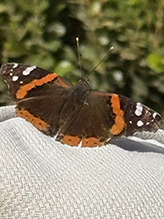 |
Greg Watson |
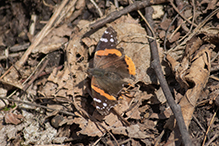 |
Mike Poeppe |
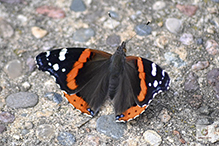 |
Kim Lind Holmgren |
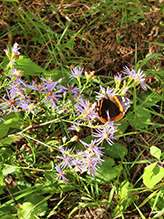 |
Alfredo Colon |
||
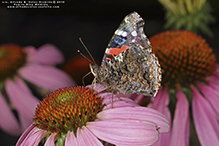 |
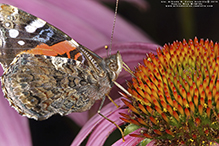 |
|
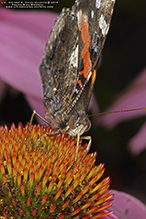 |
||
Lynn Rubey |
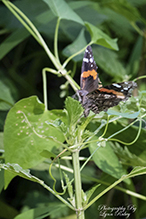 |
The Red Admiral Butterfly in The Big Stone National Wildlife Refuge. |
Gerry Garcia |
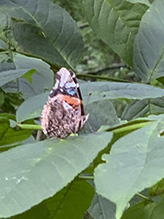 |
Richard Smaby |
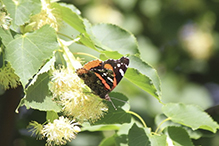 |
I had about 25 of them on a Linden tree. |
Ron Cram |
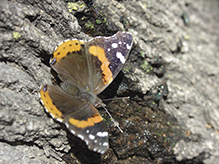 |
Unknown type butterfly eating flowing tree sap (bur oak) |
Marie Hlava |
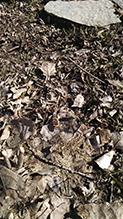 |
Front rock garden plants. It was around 11am and sunny. |
Tom Baker |
||
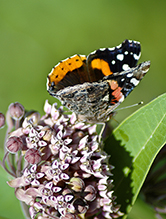 |
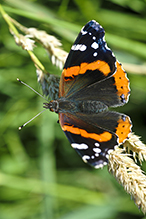 |
|
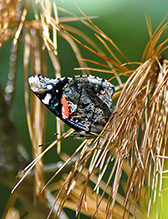 |
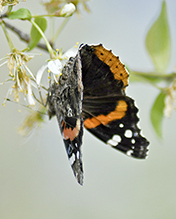 |
|
MinnesotaSeasons.com Photos |
||
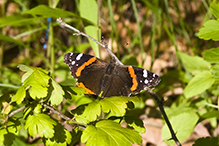 |
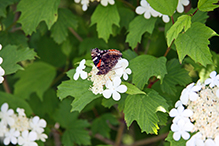 |
|
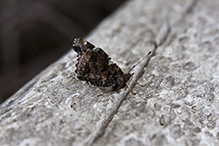 |

Slideshows |
Vanessa atalanta |
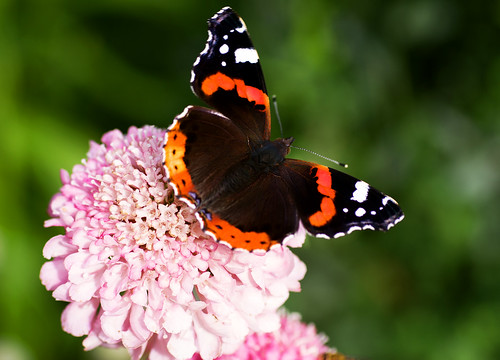
|
About
Admiralsommerfugl, Red Admiral |
Red Admiral Butterfly |
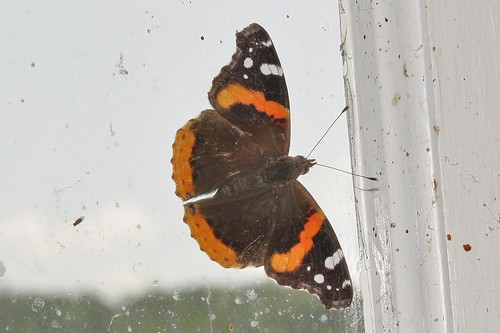
|
About
Red Admiral (Vanessa atalanta) |
Red Admiral butterfly (Vanessa atalanta) |
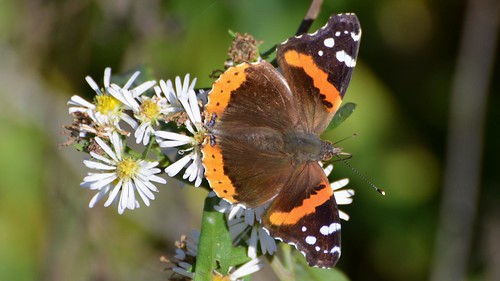
|

Visitor Videos |
||
Share your video of this insect. |
||
This button not working for you? |
||
Dan W. Andree |
"Aggressive Behavior of a Soldier Beetle Toward a Red Admiral Butterfly" |
About
Aggressive behavior of a Goldenrod Soldier beetle toward a Red Admiral butterfly. |
Other Videos |
||
Vulcana (Vanessa atalanta) |
About
Uploaded on Dec 15, 2007 Despues de pararse toda la primavera y el varano eludiéndome, esta bonita mariposa dejó que la retratara en otoño sobre los crisantemos a los que acudía todos los días. |
Chrysalis of Vanessa atalanta - Red Admiral |
About
Published on Dec 29, 2013 Gąsienica Rusałki admirała tworzy poczwarkę The Caterpillar forms a chrysalis of Red Admiral -- Vanessa atalanta Die Raupe bildet eine Puppe Schmetterling Admiral -- Vanessa atalanta Housenka vytvoří kuklu Babôčka admiralska |
Butterfly - Atalanta - Vanessa atalanta - Dudinghausen - Sauerland - Germany - 2013 - Full HD 1080p. |
About
Published on Aug 15, 2013 Atalanta (Vanessa atalanta) eet van de kersen op de weg in Dudinghausen in het Sauerland in Duitsland. (06 augustus 2013). (Sony Cyber-shot DSC-HX300). For all my photo's & video's: http://janvandenhardenberg.weebly.com. |
RED Admiral / Atalanta ( Vanessa Atalanta ) |
About
Published on Jul 7, 2013 Red Admirals can often be found on "horseshit" and Thistleflowers (Vanessa Atalanta ) Atalanta wordt vaak op paarden"stront" en distelbloemen gevonden. |
Vanessa atalanta 'Red Admiral' Butterfly |
About
Uploaded on Jun 30, 2007 If you're gardening and hoping to attract wildlife to your garden add as many Echinacea plants as you can cram in your gardening space. They attract beneficial insects like butterflies and when the seeds form they provide a good food source for native birds. Here, a number of Red Admiral butterflies are feeding on the pollen of a few of my Echinacea plants. |

Visitor Sightings |
||
Report a sighting of this insect. |
||
This button not working for you? |
||
Cliff Nitschke |
Location: Fresno, California |
 |
Greg Watson |
Location: Eagles Bluff Park, La Crescent, MN |
 |
| Susan 6/10/2023 |
Location: Blaine, MN seen late morning on my deck. |
|
| Mike Poeppe 8/8/2022 |
Location: near Houston, MN |
| Kim Lind Holmgren 9/6/2021 |
Location: Quiring, MN |
 |
| Alfredo Colon 9/29/2019 |
Location: Woodbury, Minnesota |
 |
| Lynn Rubey 8/4/2019 |
Location: Big Stone National Wildlife Refuge The Red Admiral Butterfly in The Big Stone National Wildlife Refuge. |
 |
| Gerry Garcia 7/16/2019 |
Location: Nine Mile Creek, Bloomington, MN |
 |
| Richard Smaby 7/4/2019 |
Location: Austin, MN I had about 25 of them on a Linden tree. |
 |
| Ron Cram 4/23/2019 |
Location: Canby, MN (Yellow Medicine County) Unknown type butterfly eating flowing tree sap (bur oak) |
 |
| Marie Hlava 4/8/2019 |
Location: Pine Island, MN Front rock garden plants. It was around 11am and sunny. |
 |
MinnesotaSeasons.com Sightings |
||

Created: Last Updated: © MinnesotaSeasons.com. All rights reserved. |
